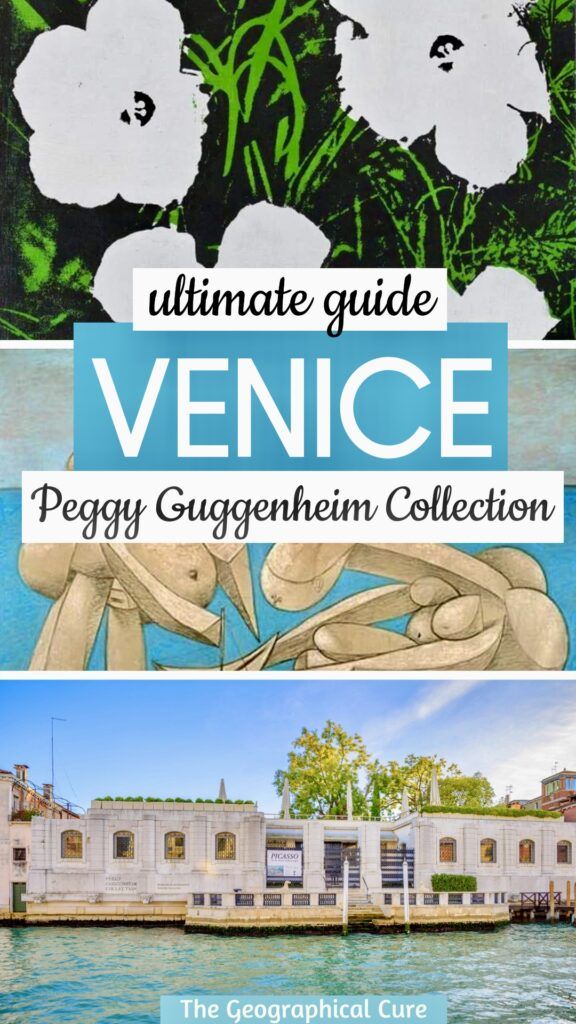“Well-behaved women don’t make history” — Laurel Thatcher Ulrich
Here’s my guide to visiting the Peggy Guggenheim Collection in Venice Italy. The collection is a modern art museum founded by the eccentric American expat Peggy Guggenheim.
The collection is one of the best museums in Italy. It’s always mobbed. So you’ll need to pre-book a skip the line ticket. You can also book a 2 hour guided tour.
Upon entering, you’re greeted by an erect penis. And Peggy planned it that way. It’s a sculpture by Marino Marini, a man astride his horse, excited by the pure joy of living in Venice.
The penis was detachable. Legend holds that Peggy took it on daily sojourns in her private gondola to signal she wasn’t home. It was stolen at a raucous party late one night, and had to be permanently welded back into its rightful place.
The penis is an emblem of both the woman and the museum. When the vivacious Peggy bought her storied paintings, they were cutting edge art. Peggy was a bit weird, and her art mirrored her personality, an “oeuvre de l’esprit.”
History of Peggy Guggenheim & Her Museum
Peggy Guggenheim was one of the 20th century’s most influential art collectors — the “mistress of modernism.”
She may also have been a sex addict, claiming in her dishy autobiography Out of This Century that she had over 1,000 lovers in Europe alone. It was a gossipy, self mortifying book that almost determinately assassinated her own character. She didn’t care.
Marguerite, only known as Peggy, was born into a wealthy Jewish family in 1898. In 1911, her father, Benjamin Guggenheim, abandoned the family entirely and moved to Paris. While traveling to visit her, he died on the Titanic, after giving up his boat seat to his French mistress.
Peggy’s sister and best friend Benita died in childbirth. Her other sister Hazel was a tragic artist, had six marriages, and two of her babies rather suspiciously fell to their death from a skyscraper. These were titanic losses for Peggy, who recalls only “protracted agony” from her childhood.
Moving to Paris at 21, Peggy rejected her conservative bourgeois background and embraced avant garde art. In her own words, she became an “art addict.” Addiction seems to have been a defining personality trait. And not one designed to promote lasting happiness.
Coached by judiciously chosen friends, Peggy decided to collect the “art of her time.” She began buying up radical contemporary art in Paris in the 1930s when it was cheap.
At the outbreak of WWII, she frenetically purchased a “picture a day.” She patrolled the ateliers of Paris, snapping up minor masterpieces for a song.
Most artists and dealers, anticipating a German attack, were desperate to unload work. Peggy claimed that artists even brought her paintings “in bed” before she rose.
Peggy’s buying spree saved many works from falling into the Nazi’s hands and being labeled “degenerate.” Think of it, a prominent Jewish woman with a decidedly Jewish name, stayed in Paris while Hitler marched, risking everything to buy and save art.
Extremely bold. Bad ass bold, almost surrealistic.
In 1941, Peggy finally escaped from occupied Paris, and fled to New York. She asked the Louvre to store her paintings. But the Louvre turned the other cheek and declined, saying they weren’t “worth saving.”
Peggy shipped her precious works to New York under a pseudonym. She also helped secret other artists out of Paris, including Ernst, Vail, and Andre Breton.
Her next move was to open a progressive museum-gallery called the Art of This Century in 1942. The gallery displayed her new works and mounted 50 exhibitions of fledgling mid-century artists.
Peggy leant critical support to the nascent group of Abstract Expressionists. Her good eye, fearless nature, and inner drive predisposed her to be a prophetic pioneer.
Peggy was an early advocate of Jackson Pollock, and called him her “great discovery.” She gave the destitute artist a retainer and sponsored his first four shows.
She even commissioned Pollock to paint a massive mural for her New York apartment, which is now one of his seminal works. It was a precursor to Pollock’s drip paintings.
Many of the artists she championed had never exhibited before, like Wassily Kandinsky, Hans Hoffman, Clyfford Still, Robert Motherwell, and Mark Rothko.
Because of this, some say her gallery was the birthplace of American modern art.
But Peggy hankered after Europe. In 1947, after divorcing Ernst, Peggy decamped to Venice for a geographical cure.
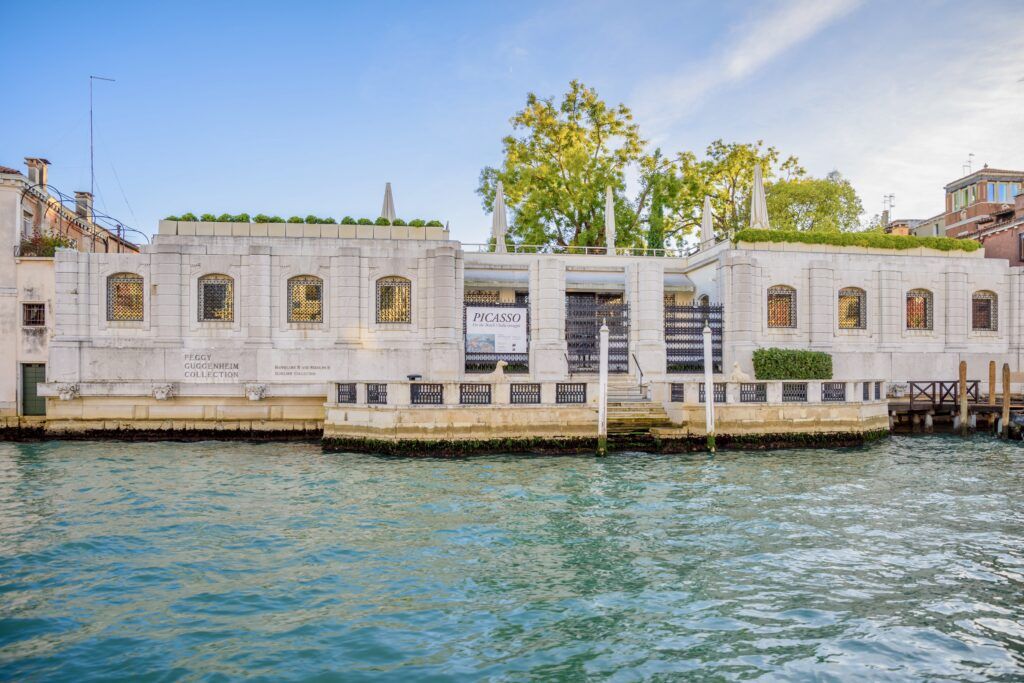
She purchased the 18th century Palazzo Venier dei Leoni on the Grand Canal for $60,000. She settled in, installed her penis sculpture, and become an eccentric Venetian socialite.
Once there, Peggy was invited to exhibit her collection in the 1948 Biennale — which gave many Europeans their first exposure to Abstract Expressionism.
By 1960, Peggy stopped buying art, as prices soared. She didn’t care for Minimalism (I have to agree), so spent her time showing off her modern collection and determining its fate after her death.
In 1951, Peggy opened her house to the public three afternoons a week from spring to fall. Venetians, who love a bit of excess and theatricality, eventually made Peggy an honorary citizen in 1961.
Peggy liked creative people. She had a lifelong preoccupation with artists and sexual conquest. She collected art and she collected artists.
She had two marriages, both to artists: “the King of Bohemians” Laurence Vail and German Surrealist Max Ernst. Neither marriage survived, amid myriad affairs and physical abuse.
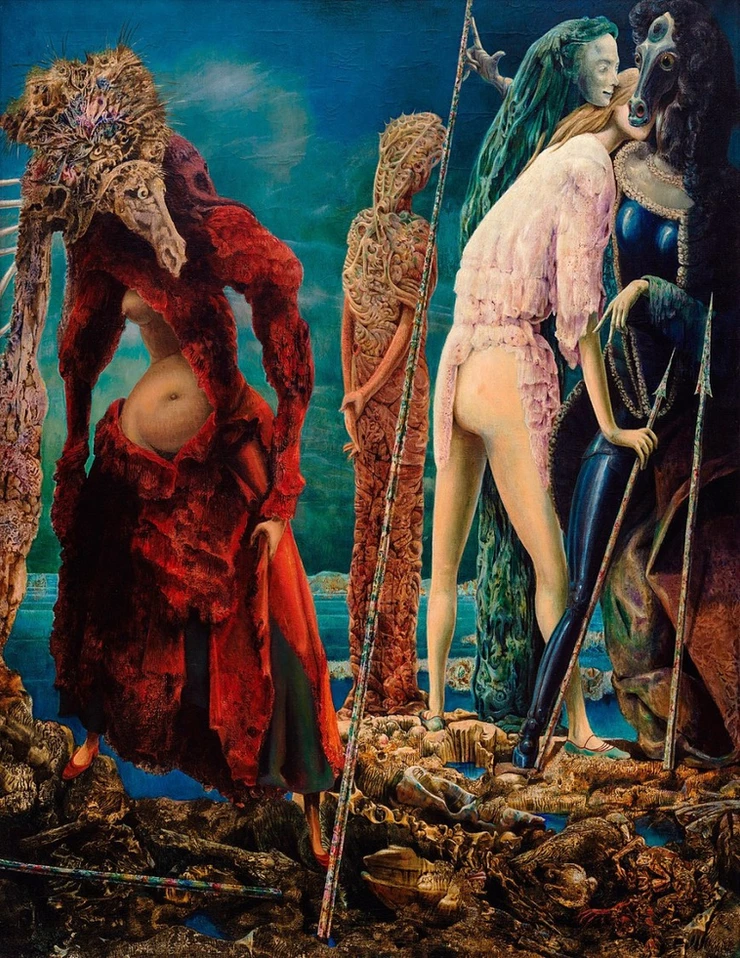
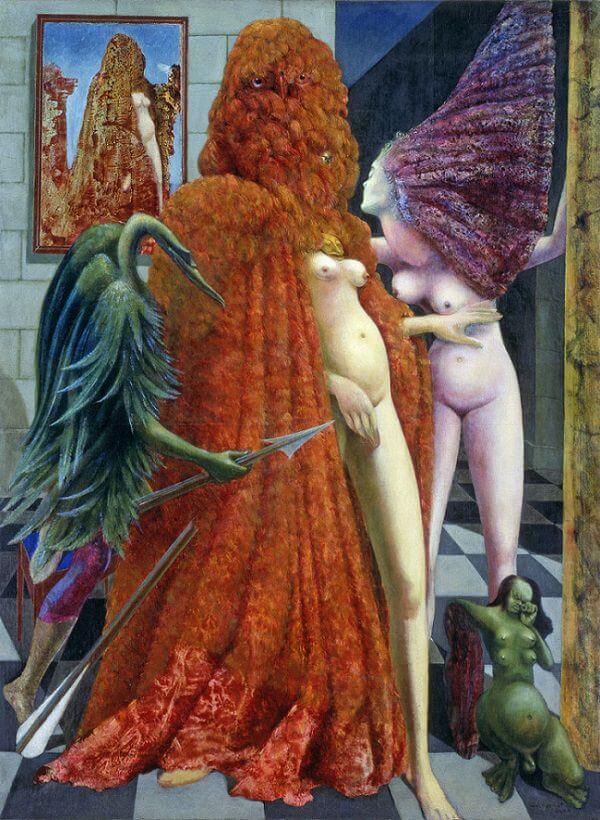
According to Peggy, Vail “made me stand for ages naked in front of the open window (in December) and threw whiskey into my eyes.” Ernst reputably married her as a career move.
Both Vail and Ernst were abusive alcoholics and beat her. Ernst stole her clothes and cross-dressed.
After Peggy secreted him out of Paris, he dumped her for a beautiful young painter. Asked why she liked Ernst, Peggy said “because he was so beautiful, because he’s such a good painter, and because he’s famous.”
She had great taste in art, but woefully poor taste in men.
Her marriages were rumpled bedsheets and temporary interludes between affairs. She slept with anyone who intrigued her.
Her most famous liaisons were with Constantin Brancusi, Samuel Beckett, Yves Tanguey, Roland Penrose, and Marcel Duchamp. She had an “unsuccessful” sexual affair with Pollack.
Like Picasso, Peggy thought sex was the greatest refreshment and never left the concession stand. She was unconventional. She didn’t care what people thought.
Peggy’s documentarian, Lisa Vreeland said, “There were no rules attached to her life when not many people were living like that.” The lack of f*cks given no doubt made her more open to abstract art, which, one may forget, was a startling concept back then.
Peggy had two children, Pegeen and Sindbad, from her first marriage. (She also had seven abortions.) She treated her children rather poorly.
Pegeen, who herself was an artist, suffered from neglect, life long depression, and committed suicide on her fifth attempt at 43.
Peggy gave up custody of Sindbad when she took up with her lover John Holmes “to be fair” to her ex-husband Vail. Sindbad later called Peggy a “bitch.”
The great love of her life was her art collection. And her fleet of Llasa Apso dogs.
At least she socialized well. Peggy’s star studded circle included many cutting edge artists and intellectuals. She was in the right place at the right time to amass a world class art collection, when few prominent collectors were buying contemporary art. She was an outrageous woman with outrageously good art.
On her death in 1979, Peggy left her life’s work to her uncle’s Soloman R. Guggenheim Foundation. Soloman was a competing art collector.
The bequest was puzzling, since they also had a fraught relationship and he undervalued her art collection. She may not have had sufficient funds to endow it herself.
Peggy’s proviso was that “the collection be kept as a whole in the palazzo” in Venice. Unlike other private art patrons, however, Peggy failed to stipulate that the collection remain intact without any change. Long running legal brouhahas ensued, spanning 1992-2018.
Peggy’s descendants sued the Foundation, claiming mismanagement. In essence, they said the collection had become less Peggy and more Soloman. The heirs sought to revoke Peggy’s donation.
The most incendiary addition to Peggy’s collection was the permanent installation of the Schulhof Collection, a donation of 80 post-war modern works.
What aggravated the heirs most was that the Schulhofs’ names were inscribed alongside Peggy’s on the museum’s sign. They basically had co-equal billing.
The curator of Peggy’s collection called it “absolutely wrong and morally objectionable to break her will. I consider it a crime. Grave robbing.”
But Peggy’s proviso was too broad. It didn’t say all works had to be permanently displayed or prohibit adding new works to the museum. The heirs’ arguments failed, though I can see why they were touchy about the sign.
One might wonder what would have happened to Peggy’s famous collection if her donation had been revoked. It would likely have been divided between heirs, dispersed, sold, and lost to the world. A horrible fate.
Guide To The Peggy Guggenheim Collection: What To See
The Peggy Guggenheim Collection was opened in 1980 and is now a shrine. It’s the single greatest museum of 20th century art in Italy. The high quality of the paintings is a tribute to Peggy’s acquisition strategy and the golden age of modern art.
The setting is intimate and you can feel Peggy’s presence. It doesn’t seem desecrated one iota. This was her art. The art she loved, personally curated, and lived with on a daily basis.
Her earrings from Alexander Calder and Yves Tanguy are even on display. I loved it. My one caveat is that, in summer, it is exceedingly crowded and can be hard to actually see the paintings. Go off season for a better experience.
The museum has three parts — Peggy’s works (the bulk of the museum), the Schulhof’s works, and the Nasher sculpture garden. There are also temporary exhibitions from time to time.
Peggy’s Collection
Peggy’s collection includes works from the major movements of Cubism, Surrealism, Futurism, and Abstract Expressionism. There’s an entire room dedicated to her beloved Pollack.
There are big names in European art. You can see works by Picasso, de Chirico, Kandinsky, Miro, Klee, Ernst, Magritte, de Kooning, Dali, and Calder. But there are also Americans like Pollock and Alexander Calder.
I loved so many paintings, it’s hard to choose my favorites. But in addition to those posted above, these are my top choices:
Alchemy
This is probably the most famous painting in the museum.
The painting exemplifies Pollock’s distinctive technique known as “drip painting,” where he skillfully dripped and poured paint onto a canvas laid horizontally on the ground.
Measuring an expansive 4 by 8 feet, Alchemy predominantly features bold black lines and drips, intermingled with sporadic touches of red, white, and gray. The resulting effect is an intricate tapestry that exudes a sense of movement and vibrancy.
Parachutists
The Parachutists” is a 1944 painting by American artist William Baziotes, known for his abstract expressionist style.
The artwork features vibrant colors, gestural brushstrokes, and a mix of organic and geometric shapes, evoking a sense of movement and energy.
Baziotes’ abstract approach invites viewers to interpret the painting’s dynamic composition in their own way, reflecting his exploration of subconscious emotions and artistic experimentation.
Empire of Light
I think this painting is the most beautiful piece in the museum. It’s a renowned painting created by the Belgian surrealist artist René Magritte from 1950.
It’s one of his most iconic and enigmatic works. Both day and night appear in the same picture. This odd juxtaposition creates a paradoxical and dreamlike atmosphere.
This composition challenges the viewer’s perception of reality and prompts contemplation about the nature of light, time, and space.
On a Beach
On the Beach is a significant artwork that exemplifies Picasso’s engagement with Surrealist concepts. In this painting, Picasso presents a scene where two central figures, a woman and a child, are seated on a beach with the sea in the background.
The woman is portrayed in a simplified and abstract manner, with flowing lines that create a sense of movement and fluidity. Her form is distorted and fragmented.
This reflects Picasso’s interest in exploring multiple perspectives and deconstructing traditional notions of representation.
The Red Tower
The Red Tower is a painting created by the Italian artist Giorgio de Chirico in 1913. De Chirico was a prominent figure in the Surrealist movement and is known for his metaphysical art style, which often featured dreamlike and enigmatic scenes.
“The Red Tower” showcases many of the elements that define de Chirico’s work. It presents a deserted and eerie urban landscape with classical architecture.
The focal point of the painting is a tall, solitary tower painted in a vibrant red color, which contrasts sharply with the surrounding muted tones.
Upward
Wassily Kandinsky’s Upward, painted in 1929, is a vibrant and dynamic abstract artwork that reflects the artist’s exploration of color, form, and spirituality.
The composition crafted entirely from geometric shapes and arranged to evoke a strong sense of vertical energy. The arrangement unfolds against a backdrop of various shades of green.
Smaller structures grace the upper right and lower left corners of the piece. The lower form takes on a shape reminiscent of the letter “E,” a nod to Empor, the painting’s German title, adding another layer of meaning to this engaging composition.
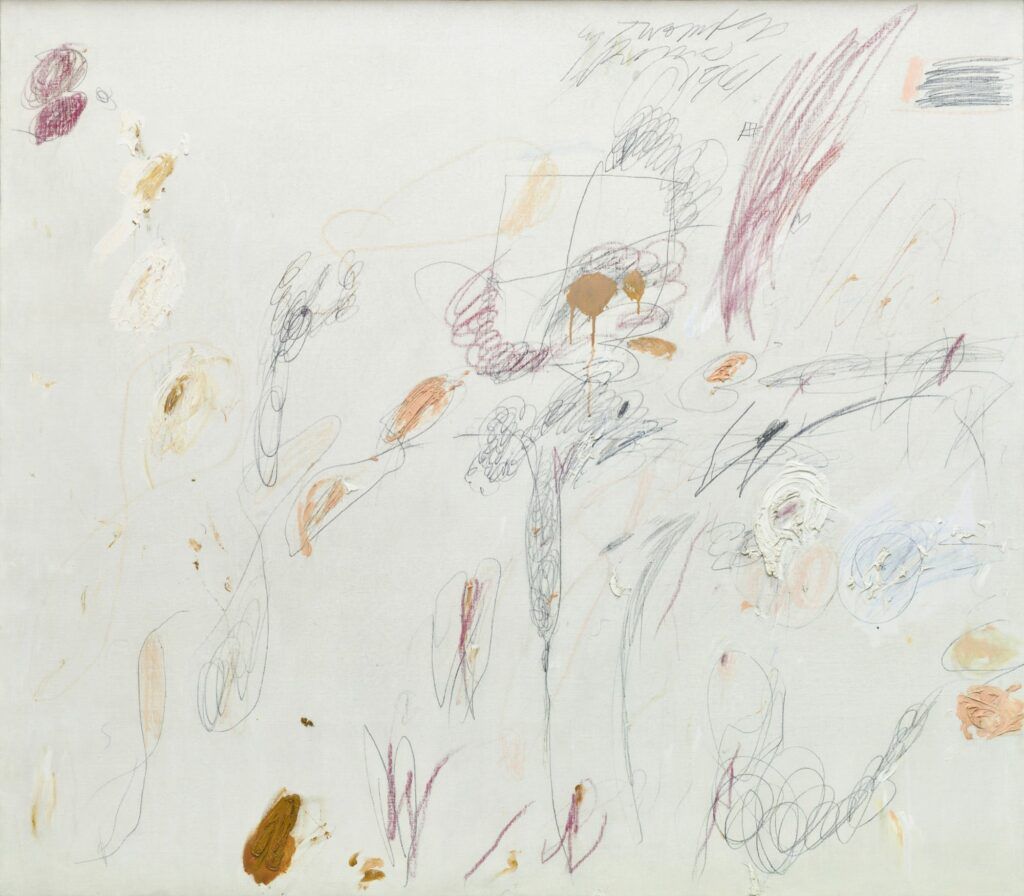
Schulhof Collection
The Schulhof bequest is also seminal. It’s housed in a wing of the museum called the Barchessa.
The collection features post-war American and European art, from a period after Peggy’s works. It extends the museum’s collection into the 1980s.
The focus is on minimalism, pop art, and post-painterly abstraction.
It includes works by he collection features artists such as Alexander Calder, Eduardo Chillida, Ellsworth Kelly, Willem de Kooning, Jean Dubuffet, Jasper Johns, Donald Judd, Anish Kapoor, Mark Rothko, Cy Twombly, and Andy Warhol.
Nasher Garden
The Nasher sculpture garden is manicured and lovely. It’s a serene oasis where art and nature harmoniously coexist.
There are works by Eduardo Chillada, Calder, Arp, Henry Moore, Alberto Giacometti, and Anish Kapoor.
Peggy’s ashes are buried in the garden as well. It’s a nice spot to step off the crowed streets of Venice.
The plaque next to Peggy’s eulogized not her lovers, but what she loved best: her 14 Llasa Apso dogs. One was oddly named after her daughter Pegeen, a happenstance which Peggy failed to grasp might upset Pegeen.
And there you have it, the world of a flamboyant, art loving wild child. Her life was as radical and original as her art. Perhaps she was her greatest creation.
It’s difficult to imagine today’s art world without her. I have a special love for the art from this period, and so I have a special love for Peggy’s Venice museum.
As Gore Vidal once said, Peggy “is the last of Henry James’s transatlantic heroines, Daisy Miller with rather more balls.” And a detachable penis.
Practical Guide & Tips for Visiting the Peggy Guggenheim Collection in Venice
Address: 704 Dorsoduro, 30123 Venice. The museum is located in the Dorsoduro district of Venice between the Accademia and Salute vaporetto stops.
Hours: open daily 10:00 am to 6:00 pm, closed Tuesday
Entry fee: adults € 16, seniors € 15 students under 26 € 9, children under 10 free
Cafe: The museum has a lovely café, which offers a picturesque view of the Grand Canal. It’s a great spot to relax and enjoy refreshments.
Pro Tip: The museum gets crowded. They are quite strict about having you check everything except a small handbag.
Tel: 041 240511
I hope you’ve enjoyed my guide to the Peggy Guggenheim Collection. You may enjoy these other Venice travel guides and resources:
- One day in Venice itinerary
- 2 days in Venice itinerary
- Guide to St. Mark’s Basilica
- Guide to the Accademia Gallery
- Guide to the Doge’s Palace
- Top Attractions on the Grand Canal
- Venice art bucket list
- How many days to spend in Venice?
- 30+ tips for visiting Venice
- Guide to the Frari Church
If you’d like to visit the Peggy Guggenheim Collection in Venice, pin it for later.
